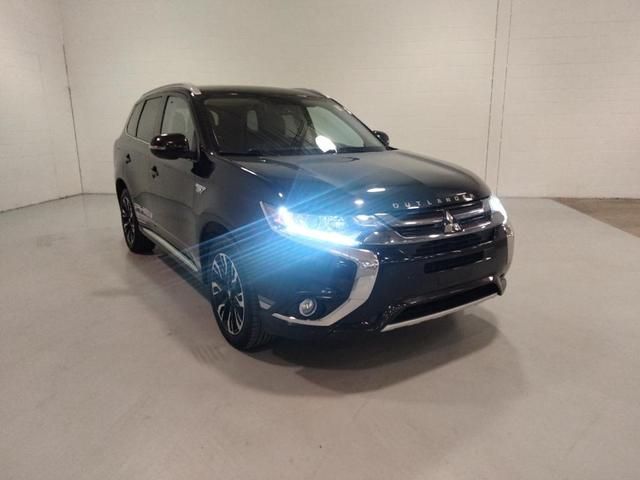
2024 MITSUBISHI OUTLANDER PHEVVIN: JA4T5WA99RZ035055
Historical Records
Collision damage reported
Damage to rear
| Year | 2024 |
| ODO | 375 mi |
| Seller | Hidden text (Hidden text) |
| MSRP | $7514 |
| Location | Murfreesboro, TN, 37129 |
| Date | appeared a day ago latest price $8430 |
| Price History | |
| Sale Website Type | classifieds |
| Notes | |
| Hidden text | |



| Body Style | SUV |
| Color | White Diamond |
| Color (Interior) | L/Gray |
| Transmission | 1-Speed Automatic |
| Engine | 2.4L I-4 DOHC, MIVEC variable valve control, regular unleaded, e |
| Drive | Four-wheel Drive |
| Fuel Type | Gasoline |
- 5415
- ABS Brakes 4-wheel antilock (ABS) brakes
- Hidden text
- All-Weather Floor Mats inc: -Floor Mats, All-Weather
- Hidden text
- Apple CarPlay
- Hidden text
- Automatic Temperature Control
- Hidden text
- Beverage holders Front beverage holders
- Hidden text
- Bumper insert Body-colored front and rear bumper inserts
- Hidden text
- Cargo cover Roll-up cargo cover
- Hidden text
- Concealed cargo storage Cargo area concealed storage
- Hidden text
- Door bins front Driver and passenger door bins
- Hidden text
- Driver attention monitor Driver attention alert
- Hidden text
- Dual Climate Control
- Hidden text
- Emergency SOS Mitsubishi Connect w/ 24-month trial vehicle integrated emerge...
- Hidden text
- Engine/electric motor temperature gage
- Hidden text
- Fob remote vehicle controls Smart device engine start control
- Hidden text
- Front camera Front mounted camera
- Hidden text
- Front side impact airbag driver Seat mounted side impact driver airbag
- Hidden text
- Gearshifter material Leather and metal-look gear shifter material
- Hidden text
- Headliner material Cloth headliner material
- Hidden text
- High mount stop light High mounted center stop light
- Hidden text
- Instrumentation display Digital/analog instrumentation display
- Hidden text
- Knee airbag Driver side knee airbag
- Hidden text
- Leather Steering Wheel
- Hidden text
- Memory Seat
- Hidden text
- Number of doors 4 doors
- Hidden text
- Overhead airbags Curtain first and second-row overhead airbags
- Hidden text
- Passenger doors rear right Conventional right rear passenger door
- Hidden text
- Power Passenger Seat
- Hidden text
- Radio data system
- Hidden text
- Rear Spoiler
- Hidden text
- Rear head restraint control Manual rear seat head restraint control
- Hidden text
- Rear sun blinds Manual rear side window sunblinds
- Hidden text
- Remote Keyless Entry
- Hidden text
- Satellite trial 3 month satellite trial subscription
- Hidden text
- Security System
- Hidden text
- Speakers number 6 speakers
- Hidden text
- Spoiler Rear lip spoiler
- Hidden text
- Steering type number of wheels 2-wheel steering system
- Hidden text
- Tachometer
- Hidden text
- Third-row seat fixed or removable Fixed third-row seats
- Hidden text
- Tires P255/45WR20 AS BSW front and rear tires
- Hidden text
- Transfer case Electronic transfer case shift
- Hidden text
- Twin Motor S-AWC (Super All-Wheel Control)
- Hidden text
- Visor illuminated passenger mirror Illuminated passenger visor mirror
- Hidden text
- Wipers Variable intermittent front windshield wipers
- 5276
- 3rd Row Seats: Split-Bench
- Hidden text
- Adaptive Cruise Control
- Hidden text
- Android Auto & Apple CarPlay
- Hidden text
- Auto high-beam headlights Auto High Beams (AHB) auto high-beam headlights
- Hidden text
- Battery charge warning
- Hidden text
- Brake Assist
- Hidden text
- Cabin air filter
- Hidden text
- Child door locks Manual rear child safety door locks
- Hidden text
- DC Fast Charging Capability
- Hidden text
- Door mirror with tilt-down in reverse Power driver and passenger door mirror...
- Hidden text
- Driver selectable regen levels
- Hidden text
- Electric powertrain PHEV (plug-in hybrid electric vehicle)
- Hidden text
- Engine Location Front mounted engine
- Hidden text
- Floor coverage Full floor coverage
- Hidden text
- Four Wheel Independent Suspension
- Hidden text
- Front impact airbag passenger Passenger front impact airbag
- Hidden text
- Full gage cluster screen
- Hidden text
- Headlight washers Front headlight washers
- Hidden text
- Heated front seats Heated driver and front passenger seats
- Hidden text
- Illuminated entry
- Hidden text
- Keyfob door locks Keyfob activated door locks
- Hidden text
- Leather appointed seating surfaces
- Hidden text
- Low Tire Pressure Warning
- Hidden text
- Multiple headlights Multiple enclosed headlights
- Hidden text
- One-touch down window Front and rear one-touch down windows
- Hidden text
- Panic alarm
- Hidden text
- Power Liftgate
- Hidden text
- Primary display touchscreen Primary monitor touchscreen
- Hidden text
- Real time weather Real-time weather
- Hidden text
- Rear climate control Rear climate control system with separate controls
- Hidden text
- Rear seat upholstery Leather rear seat upholstery
- Hidden text
- Rearview mirror Auto-dimming rear view mirror
- Hidden text
- Roof Rack: Rails Only
- Hidden text
- Second-row bench seats Split-bench second-row seat
- Hidden text
- Shutters Active grille shutters
- Hidden text
- Speedometer Redundant digital speedometer
- Hidden text
- Steering Electric power-assist steering system
- Hidden text
- Suspension ride type front Independent front suspension
- Hidden text
- Third-row fold into floor seats Manual fold into floor third-row seat
- Hidden text
- Tilt steering wheel
- Hidden text
- Traction battery warranty 120 month/100000 miles
- Hidden text
- Trunk hatch Trunk/hatch auto-latching
- Hidden text
- Variably Intermittent Wipers
- Hidden text
- Wheels 20 x 8-inch front and rear machined w/painted accents aluminum wheels...
- Hidden text
- 12V power outlets 2 12V power outlets
- 8642
- ABS Brakes
- Hidden text
- Alloy Wheels
- Hidden text
- Armrests front storage Front seat armrest storage
- Hidden text
- Axle Ratio: TBD
- Hidden text
- Blind Spot Monitor
- Hidden text
- Bumper rub strip rear Metal-look rear bumper rub strip
- Hidden text
- Cargo light Cargo area light
- Hidden text
- Console insert material Piano black and aluminum console insert
- Hidden text
- Door handle material Body-colored door handles
- Hidden text
- Driver Foot Rest
- Hidden text
- Dual front side impact airbags
- Hidden text
- Emissions LEV3-SULEV30 emissions
- Hidden text
- External memory External memory control
- Hidden text
- Folding door mirrors Power folding door mirrors
- Hidden text
- Front Fog Lights
- Hidden text
- Fuel Type Regular Unleaded
- Hidden text
- Grille style Black grille with chrome accents
- Hidden text
- Heated Seats
- Hidden text
- Hood Emblem (Satin) inc: -Hood Emblem, OUTLANDER Satin
- Hidden text
- Interior accents Chrome and metal-look interior accents
- Hidden text
- Led Fog Lights
- Hidden text
- Limited slip center differential
- Hidden text
- Memory settings Memory settings include: door mirrors
- Hidden text
- Number of memory settings 2 memory settings
- Hidden text
- Overhead console Mini overhead console
- Hidden text
- Passenger Vanity Mirror
- Hidden text
- Power Steering
- Hidden text
- Rain sensing front wipers
- Hidden text
- Rear air conditioning
- Hidden text
- Rear pedestrian detection Rear pedestrian detection warning
- Hidden text
- Rear Window Defroster
- Hidden text
- Right camera Right side camera
- Hidden text
- Seatback storage pockets 4 seatback storage pockets
- Hidden text
- Selectable Terrain Modes
- Hidden text
- Speed control
- Hidden text
- Springs rear Rear coil springs
- Hidden text
- Steering Wheel Mounted Audio Controls
- Hidden text
- Tailpipe Stainless steel single exhaust
- Hidden text
- Third-row seatback upholstery Carpet third-row seatback upholstery
- Hidden text
- Towing trailer sway Trailer sway control
- Hidden text
- Transmission Type Automatic
- Hidden text
- USB ports 4 USB ports
- Hidden text
- Voice activated audio Voice activated audio controls
- Hidden text
- Wireless streaming Bluetooth wireless audio streaming
- 4110
- 8-Way Power Adjustable Driver Seat With Memory For Seat And Outside Mirror L...
- Hidden text
- Air conditioning Yes
- Hidden text
- Anti-roll bar rear Rear anti-roll bar
- Hidden text
- AUTOMATIC BRAKE HOLD
- Hidden text
- Bench seats Third-row split-bench seat
- Hidden text
- Brake type 4-wheel disc brakes
- Hidden text
- Cargo access Proximity cargo area access release
- Hidden text
- Clock In-radio display clock
- Hidden text
- Door ajar warning Rear cargo area ajar warning
- Hidden text
- Drive type S-AWC four-wheel drive
- Hidden text
- Drivetrain selectable Driver selectable drivetrain mode
- Hidden text
- Electronic stability control Active Stability Control (ASC) electronic stabi...
- Hidden text
- Engine temperature warning
- Hidden text
- Fob engine controls FAST-Key with hands-free access and push button start
- Hidden text
- Front Anti-Roll Bar
- Hidden text
- Front seatback upholstery Leatherette front seatback upholstery
- Hidden text
- Gage cluster display size (inches) Gage cluster display size: 12.30
- Hidden text
- Headliner coverage Full headliner coverage
- Hidden text
- Height adjustable seatbelts Front height adjustable seatbelts
- Hidden text
- Immobilizer
- Hidden text
- Knee Airbag
- Hidden text
- Leather shift knob
- Hidden text
- Maintenance warranty 24 month/30,000 miles
- Hidden text
- Number of beverage holders 10 beverage holders
- Hidden text
- Overhead Airbag
- Hidden text
- Passenger doors rear left Conventional left rear passenger door
- Hidden text
- Power driver seat controls Driver seat power reclining, lumbar support, cush...
- Hidden text
- Radio AM/FM/digital/SiriusXMsatellite
- Hidden text
- Rear Door Pull-Up Sunshade
- Hidden text
- Rear head restraint control 3 rear seat head restraints
- Hidden text
- Rear side impact airbag Rear side impact airbags
- Hidden text
- Regenerative brakes
- Hidden text
- Standard
- Hidden text
- Second-row windows Power second-row windows
- Hidden text
- Speakers Standard grade speakers
- Hidden text
- Spoiler
- Hidden text
- Steering type Rack-pinion steering
- Hidden text
- Suspension type rear Multi-link rear suspension
- Hidden text
- Third-row seat facing Front facing third-row seat
- Hidden text
- Tire pressure Tire pressure fill assist
- Hidden text
- Traffic sign information Traffic Sign Recognition (TSR) with speed limiter f...
- Hidden text
- Turn Signal Indicator Mirrors
- Hidden text
- Visor illuminated driver mirror Illuminated driver visor mirror
- Hidden text
- Windshield trim Black windshield trim
- 3510
- 4WD type S-AWC part and full-time 4WD
- Hidden text
- Air Conditioning
- Hidden text
- Anti-roll bar front Front anti-roll bar
- Hidden text
- Automatic Emergency Braking
- Hidden text
- Battery type Lead acid battery
- Hidden text
- Brake assist system
- Hidden text
- Capless fuel filler
- Hidden text
- Climate control Automatic climate control
- Hidden text
- Day/night rearview mirror
- Hidden text
- Door trim insert Leatherette door trim insert
- Hidden text
- Driver Vanity Mirror
- Hidden text
- Electronic parking brake
- Hidden text
- Engine block material Aluminum engine block
- Hidden text
- Floor mats Carpet front and rear floor mats
- Hidden text
- Front Center Armrest w/Storage
- Hidden text
- Front seat upholstery Alcantara leather front seat upholstery
- Hidden text
- GPS linked cruise control
- Hidden text
- HEADLIGHTS ON REMINDER
- Hidden text
- Heated wipers Heated windshield wiper park
- Hidden text
- Illuminated ignition switch
- Hidden text
- Keyless Start
- Hidden text
- Leather Seats
- Hidden text
- MI-PILOT Assist w/ Navi-link Adaptive Cruise Control (ACC) with Stop & Go La...
- Hidden text
- Number of airbags 10 airbags
- Hidden text
- Outside temperature display
- Hidden text
- Passenger Door Bin
- Hidden text
- Power Driver Seat
- Hidden text
- radiator
- Hidden text
- Rear Cross Traffic Alert
- Hidden text
- Rear console climate control ducts
- Hidden text
- Rear Side Impact Airbag
- Hidden text
- Reclining second-row seats Manual reclining second-row seats
- Hidden text
- SAE Autonomy Level 2 - partial automation SAE Autonomy
- Hidden text
- Second-row seats fixed or removable Fixed second-row seats
- Hidden text
- Smart device integration Android Auto & Apple CarPlay smart device wireless ...
- Hidden text
- Split front seats Bucket front seats
- Hidden text
- Steering mounted audio control Steering wheel mounted audio controls
- Hidden text
- Suspension type front Strut front suspension
- Hidden text
- Third-row head restraints Fixed third-row head restraints
- Hidden text
- Tire mobility kit
- Hidden text
- Traction control All-speed ABS and driveline traction control
- Hidden text
- Turn signal in door mirrors Turn signal indicator in door mirrors
- Hidden text
- Visor driver mirror Driver visor mirror
- Hidden text
- Window Trim Chrome side window trim
VIN Decoder — 58 records
Anti-lock Braking System (ABS) means a portion of a service brake system that automatically controls the degree of rotational wheel slip during braking by: (1) Sensing the rate of angular rotation of the wheels; (2) Transmitting signals regarding the rate of wheel angular rotation to one or more controlling devices that interpret those signals and generate responsive controlling output signals; and (3) Transmitting those controlling signals to one or more modulator devices that adjust brake actuating forces in response to those signals.
An auto-reverse system enables power windows and sunroofs on motor vehicles to automatically reverse direction when such power windows and panels detect an obstruction. This feature can prevent children and others from being trapped, injured, or killed by the power windows and sunroofs.
ESC is a computerized technology that improves a vehicle's stability by detecting and reducing loss of traction (skidding). When ESC detects loss of steering control, it automatically applies the brakes to help steer the vehicle in the driver's intended direction. Braking is automatically applied to wheels individually, such as the outer front wheel to counter oversteer, or the inner rear wheel to counter understeer. Some ESC systems also reduce engine power until control is regained.
A keyless ignition system permits starting a car without a physical key being inserted into an ignition. Instead, a small device known as a "key fob" transmits a code to a computer in the vehicle when the fob is within a certain close range. When the coded signal matches the code embedded in the vehicle's computer, a number of systems within the car are activated, including the starter system. This allows the car to be started by simply pressing a button on the dashboard while the key fob is left in a pocket or a purse. The vehicle is usually shut down by pushing the same button.
A TPMS is an electronic system designed to monitor the air pressure inside the pneumatic tires on various types of vehicles. TPMS can be divided into two different types - direct and indirect. Direct TPMS employ pressure sensors on each wheel, either internal or external. The sensors physically measure the tire pressure in each tire and report it to the vehicle's instrument cluster or a corresponding monitor. Indirect TPMS does not use physical pressure sensors but measure air pressures by monitoring individual wheel rotational speeds and other signals available outside of the tire itself.
When the traction control computer detects a driven wheel or wheels spinning significantly faster than another, it invokes an electronic control unit to apply brake friction to wheels spinning due to loss of traction. This braking action on slipping wheels will cause power transfer to the wheels with traction due to the mechanical action within the differential.
A backup camera, also known as a rearview video system, helps prevent back-over crashes and protects our most vulnerable people - children and senior citizens - by providing an image of the area behind the vehicle. A backup camera helps the driver see behind the vehicle while in reverse.
A parking assist system uses computer processors, back up cameras, surround-view cameras, and sensors to assist with steering and other functions during parking. Drivers may be required to accelerate, brake, or select gear position. Some systems are capable of parallel and perpendicular parking. Drivers must constantly supervise this support feature and maintain responsibility for parking.
A CIB system is an automatic emergency braking system designed to detect an impending forward crash with another vehicle. CIB systems automatically apply the brakes in a crash imminent situation to slow or stop the vehicle, avoiding the crash or reducing its severity, if the driver does not brake in response to a forward collision alert.
A DBS system is an automatic emergency braking system designed to detect an impending forward crash with another vehicle. DBS systems automatically supplement the driver's braking in an effort to avoid a crash if the driver does not brake hard enough to avoid it.
An FCW system monitors a vehicle's speed, the speed of the vehicle in front of it, and the distance between the vehicles. If the vehicles get too close due to the speed of either vehicle, the FCW system will warn the driver of the rear vehicle of an impending crash so that the driver can apply the brakes or take evasive action, such as steering, to prevent a potential crash. FCW systems provide an audible, visual, or haptic warning, or any combination thereof, to alert the driver of an FCW-equipped vehicle of a potential collision.
BSW alerts drivers with an audio or visual warning if there are vehicles in adjacent lanes that the driver may not see when making a lane change.
An LDW system monitors lane markings and alerts the driver if their vehicle drifts out of their lane without a turn signal or any control input indicating the lane departure is intentional. An audio, visual or other alert warns the driver of the unintentional lane shift so the driver can steer the vehicle back into its lane.
DRL is an automotive lighting system on the front of a vehicle or bicycle, that automatically switches on when the vehicle is in drive, and emits white, yellow, or amber light to increase the conspicuity of the vehicle during daylight conditions.
A headlamp light source provides a distribution of light designed to provide adequate forward and lateral illumination with limits on light directed towards the eyes of other road users, to control glare. This beam is intended for use whenever other vehicles are present ahead. Halogen, high-Intensity discharge (HID), light-emitting diode (LED), and laser are the most common headlights on the market.
A semi-automatic headlamp beam switching device provides automatic or manual control of beam switching at the option of the driver. When the control is automatic, the headlamps switch from the upper beam to the lower beam when illuminated by the headlamps on an approaching car and switch back to the upper beam when the road ahead is dark. When the control is manual, the driver may obtain either beam manually regardless of the condition of lights ahead of the vehicle.
Engine displacement (in cubic centimeters) is the volume swept by all the pistons inside the cylinders of a reciprocating engine in a single movement from top dead center to bottom dead center.
Engine displacement (in cubic inches) is the volume swept by all the pistons inside the cylinders of a reciprocating engine in a single movement from top dead center to bottom dead center.
Engine displacement (in liters) is the volume swept by all the pistons inside the cylinders of a reciprocating engine in a single movement from top dead center to bottom dead center.
Electrification level defines to what level the vehicle is powered by electric system. The common electric system configurations are mild hybrid, strong hybrid, plug-in hybrid, battery electric, and fuel cell vehicles.
(1) Mild hybrid is the system such as 12-volt start-stop or 48-volt belt integrator starter generator (BISG) system that uses an electric motor to add assisting power to the internal combustion engine. The system has features such as stop-start, power assist, and mild level of generative braking features.
(2) Strong hybrid systems, in vehicles such as the Toyota Prius, mainly consist of motors, conventional gasoline engine, and battery, but the source of electrical charge for the battery power is provided by the conventional engine and/or regenerative braking.
(3) Plug-in hybrid systems, in vehicles such as the Toyota Rav4 Prime, mainly consist of motors, conventional gasoline engine and battery. Plug-in hybrid vehicles are like strong hybrids, but they have a larger battery pack and can be charged with an external source of electricity by electric vehicle supply equipment (EVSE).
(4) Battery electric vehicles (BEV), such as the Tesla Model S or Nissan Leaf, have only a battery and electrical motor components and use electricity as the only power source.
(5) Fuel cell electric vehicles (FCEV) use full electric drive platforms but consume electricity generated by onboard fuel cells and hydrogen fuel.
Engine brake is the horsepower (hp) at the engine output shaft. Engine Brake (hp) From is the lower value of the range.
Engine configuration defines how engine cylinders are arranged. Common values are V6 for V-shaped arrangement, I4 or L4 for in-line arrangement.
This is a numerical field to store the number of cylinders in an engine. Common values for passenger cars are 4 or 6.
Fuel type defines the fuel used to power the vehicle. For vehicles that have two power sources, such as plug-in hybrid vehicle, both primary fuel type and secondary fuel type will be provided.
Body Class presents the body type based on 49 CFR 565.12(b): "Body type means the general configuration or shape of a vehicle distinguished by such characteristics as the number of doors or windows, cargo-carrying features and the roofline (e.g., sedan, fastback, hatchback)." Definitions are not provided for individual body types in the regulation.
Gross vehicle weight rating (GVWR) is the maximum operating weight of a vehicle including the vehicle's chassis, body, engine, engine fluids, fuel, accessories, driver, passengers and cargo, but excluding that of the trailers. Per 49 CFR 565.15, Class 1 is further broken down to Class A-D; Class 2 is further broken down to Class E-H. This field captures the lower bound of GVWR range for the vehicle.
Per 49 CFR 565, Model means a name that a manufacturer applies to a family of vehicles of the same type, make, line, series and body type.
If the model year (MY) is supplied when the VIN is decoded, such as from a crash report or a vehicle registration record, the MY value will be the supplied MY, even if the MY decoded from the VIN differs from the supplied MY. If the MY is not supplied when the VIN is decoded, the MY value will be decoded from the 10th character in the VIN.
Note is used to store any additional information that does not correspond to any of the specified fields on the interface. This is a catch-all element for systems other than for engine, restraint system, brake and battery. Engine, restraint system, brake, and battery have their own note elements.
This data element captures the city of the manufacturing plant where the manufacturer affixes the VIN.
This data element captures the name of the company that owns the manufacturing plant where the manufacturer affixes the VIN.
This data element captures the country of the manufacturing plant where the manufacturer affixes the VIN.
This data element captures the State or Province name within the Plant Country of the manufacturing plant where the manufacturer affixes the VIN.
This field captures the location of curtain air bags. Curtain air bags are side air bags that protect the head.



































